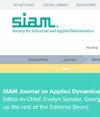The Rocking Can: A Reduced Equation of Motion and a Matched Asymptotic Solution
IF 1.8
4区 数学
Q2 MATHEMATICS, APPLIED
引用次数: 0
Abstract
SIAM Journal on Applied Dynamical Systems, Volume 22, Issue 4, Page 3358-3389, December 2023.Abstract. The rocking can problem [M. Srinivasan and A. Ruina, Phys. Rev. E, 78 (2008), 066609] consists of an empty drinks can standing upright on a horizontal plane which, when tipped back to a single contact point and released, rocks down towards the flat and level state. At the bottom of the motion, the contact point moves quickly around the rim of the can. The can then rises up again, having rotated through some finite angle of turn [math]. We recast the problem as a second order ODE and find a Frobenius solution. We then use this Frobenius solution to derive a reduced equation of motion. The rocking can exhibits two distinct phenomena: behavior very similar to an inverted pendulum, and dynamics with the angle of turn. This distinction allows us to use matched asymptotic expansions to derive a uniformly valid solution that is in excellent agreement with numerical calculations of the reduced equation of motion. The solution of the inner problem was used to investigate of the angle of turn phenomenon. We also examine the motion of the contact locus [math] and see a range of different trajectories, from circular to petaloid motion and even cusp-like behavior. Finally, we obtain an approximate lower bound for the required coefficient of friction to avoid slip.
摇摆罐简化运动方程和匹配渐近解
SIAM 应用动力系统期刊》,第 22 卷第 4 期,第 3358-3389 页,2023 年 12 月。 摘要。摇罐问题 [M. Srinivasan and A. Ruina, Phys. Rev. E, 78 (2008), 066609] 包含一个直立在水平面上的空饮料罐。在运动的底部,接触点围绕罐子边缘快速移动。然后,罐子再次上升,旋转了某个有限的角度[数学]。我们将问题重塑为一个二阶 ODE,并找到一个 Frobenius 解。然后,我们利用这个弗罗贝尼斯解推导出一个简化的运动方程。摇摆可以表现出两种截然不同的现象:与倒立摆非常相似的行为,以及随转角变化的动力学。这种区别使我们能够使用匹配的渐近展开求出统一有效的解,该解与简化运动方程的数值计算结果非常吻合。内部问题的解被用来研究转角现象。我们还研究了接触点的运动[math],看到了一系列不同的轨迹,从圆周运动到花瓣运动,甚至是类似尖顶的行为。最后,我们得到了避免滑移所需的摩擦系数的近似下限。
本文章由计算机程序翻译,如有差异,请以英文原文为准。
求助全文
约1分钟内获得全文
求助全文
来源期刊

SIAM Journal on Applied Dynamical Systems
物理-物理:数学物理
CiteScore
3.60
自引率
4.80%
发文量
74
审稿时长
6 months
期刊介绍:
SIAM Journal on Applied Dynamical Systems (SIADS) publishes research articles on the mathematical analysis and modeling of dynamical systems and its application to the physical, engineering, life, and social sciences. SIADS is published in electronic format only.
 求助内容:
求助内容: 应助结果提醒方式:
应助结果提醒方式:


